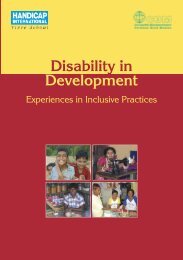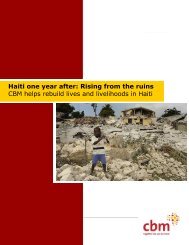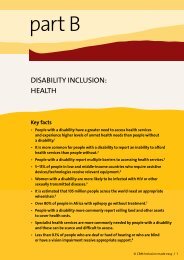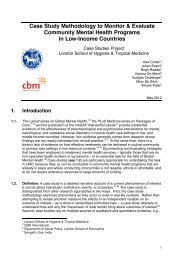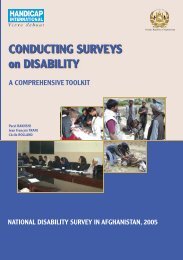Vision 2020 - World Health Organization
Vision 2020 - World Health Organization
Vision 2020 - World Health Organization
You also want an ePaper? Increase the reach of your titles
YUMPU automatically turns print PDFs into web optimized ePapers that Google loves.
APPROACHES TO PREVENTION OF VISUAL IMPAIRMENT<br />
2.2 DISEASE CONTROL AND PREVENTION OF VISUAL IMPAIRMENT CHILDHOOD BLINDNESS<br />
Aim<br />
• to eliminate avoidable causes of blindness in children<br />
Objectives<br />
• to promote programmes that reduce corneal scarring and visual loss from vitamin A defi ciency<br />
and measles and to implement interventions against harmful traditional practices, neonatal conjunctivitis<br />
and eye injuries;<br />
• to provide services to treat children with cataract, glaucoma, retinopathy of prematurity and corneal<br />
ulcer or scarring;<br />
• to provide optical services for children with refractive errors, for instance in school eye-health<br />
programmes; and<br />
• to provide services for children with low vision.<br />
Strategies<br />
• Provide comprehensive services for children at all levels of service delivery.<br />
• In areas where childhood blindness from preventable diseases is common, increase awareness in<br />
the community and encourage primary health care, including specifi c preventive measures at the<br />
primary level, through primary eye care, including:<br />
• measles immunization, to prevent corneal scarring;<br />
• vitamin A supplementation, nutrition education, food supplementation and fortifi cation of commonly<br />
eaten foods with vitamin A, to control vitamin A defi ciency;<br />
• avoidance of harmful traditional practices, to prevent corneal scarring;<br />
• ocular prophylaxis of newborns, to prevent neonatal conjunctivitis; and<br />
• rubella immunization where congenital rubella is an important cause of mortality or morbidity<br />
in children, with strategies appropriate to the setting (e.g. schoolgirls aged 12–13 years).<br />
• At the secondary level, strengthen diagnosis and management of less complex cases.<br />
• At the tertiary level, provide specialist training and services for the management of surgically<br />
remediable visual loss from cataract, congenital glaucoma and corneal scarring, including longterm<br />
follow up. Examine premature infants at risk of retinopathy of prematurity, treat those with<br />
severe disease and promote oxygen monitoring.<br />
• As children with cataract often do not present, or present late, undertake active case fi nding,<br />
particularly for girls.<br />
• Provide each child eye-care centre with a well-trained team (e.g. paediatric or child-centred<br />
ophthalmologist, optometrist, anaesthetist, counsellor, low-vision therapist, mid-level personnel),<br />
appropriate equipment and infrastructure and access to consumables for infants and children (e.g.<br />
small spectacle frames, high-power intraocular lenses).<br />
• Ensure the availability of ophthalmologists experienced in indirect ophthalmoscopy to identify<br />
premature infants in intensive neonatal care who require treatment for retinopathy of prematurity.<br />
23






